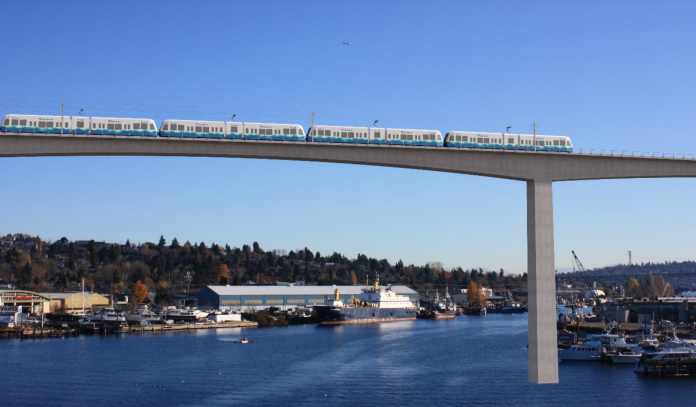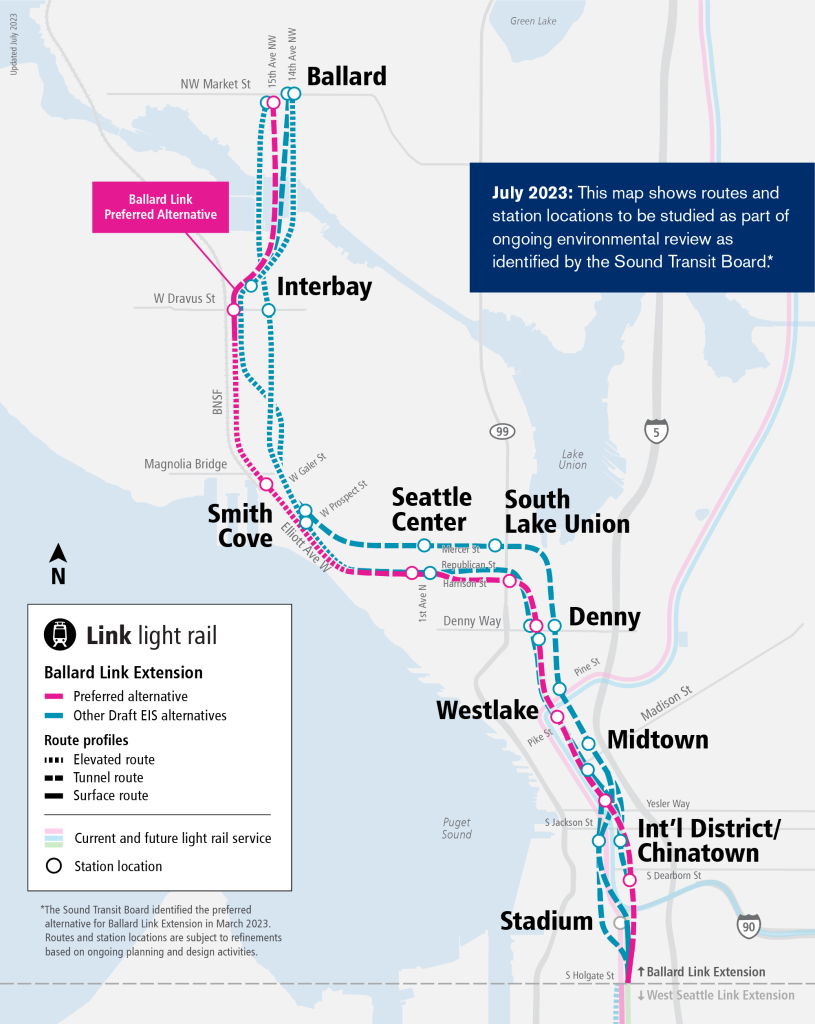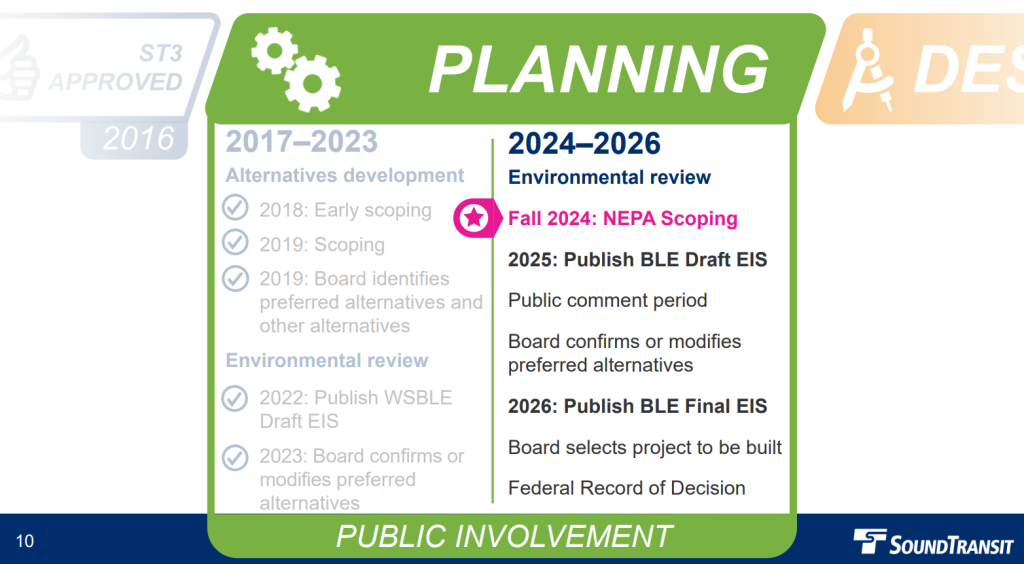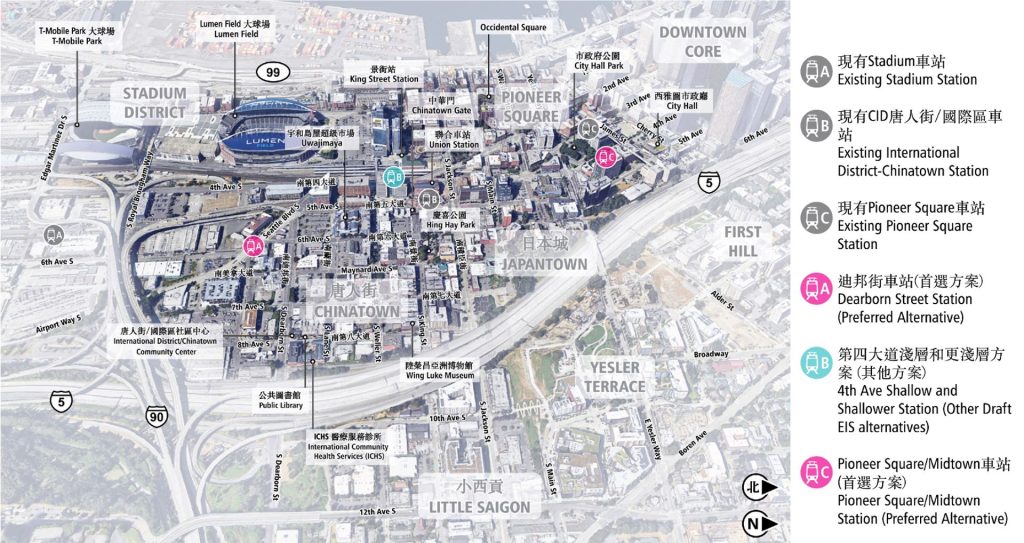
As the Sound Transit board advances the West Seattle Link project into final design, Ballard Link remains mired in planning work, despite being the more regionally important light rail line. Originally, the two light rail projects had been tied together, with the initial Draft Environmental Impact Statement (DEIS) released in the same document in 2022. However, since that time, Ballard Link has fallen behind and isn’t expected to be advanced into final design until 2026, nearly a full decade after the passage of the Sound Transit 3 ballot measure.
Delivering light rail to both West Seattle and Ballard is consistently ranked as a top priority for Seattle residents. A recent poll conducted by the Seattle Metropolitan Chamber of Commerce found 66% of respondents stated they support keeping the projects on track to open in 2032, even if it costs more. That makes light rail extensions within the city more popular than bringing back the Seattle Sonics, but Sound Transit’s own timelines don’t quite stack up with those expectations.
While 2032 remains the target date for the four-station West Seattle extension, nine-station Ballard Link, including a second light rail tunnel under Downtown Seattle, remains further behind with a planned opening date of 2039. Those target dates may need to delayed further due to cost overruns recently revealed for West Seattle Link and hinted at for Ballard Link. The original timeline for opening as presented to voters would have had service starting in 2035.
The full extent of the delay set in motion by the Sound Transit board’s 2023 vote to add and select as preferred brand new alternatives skipping the CID and Midtown was not revealed at the time. In the fall of 2023, public-facing project schedules were still showing Ballard Link wrapping design in 2027 and starting construction that same year. Since then, the timeline has been revised to show design work wrapping up in 2030 — a slippage of three years. The agency’s branding efforts to portray the new planning work as a “supplemental DEIS” and a minor speedbump has not translated into reality.
If the Sound Transit board hadn’t gone off-script to select new preferred station locations in Seattle’s south downtown in early 2023, the Ballard Link project would likely be much further along right now. With the additional analysis required to evaluate the option of skipping the initially-planned station adjacent to the existing Chinatown-International District (CID) station and instead siting stations in Pioneer Square and in South CID near Uwajimaya — options that were not in the first DEIS — Ballard Link had to be spun off into onto a planning track of its own.
That’s where things get wonky when it comes to the hoops Sound Transit has to jump through to be eligible for Federal Transit Administration (FTA) funding.

Because Sound Transit had already issued a Notice of Intent (NOI) to issue environmental documentation for West Seattle and Ballard as one project, the FTA notified the agency that it had to issue a separate NOI for Ballard after spinning it off, with the original NOI now only applying to West Seattle. Even though scoping already occurred in both 2018 and 2019, when the board had already identified a preferred alternative, another scoping period is required. As far as the National Environmental Policy Act (NEPA) is concerned, Ballard Link is starting back at square one.
Sound Transit had initially scheduled meetings to collect scoping feedback in October, but had to cancel them thanks to delays on FTA’s end.
“FTA is delayed in publishing the notice of intent (NOI) in the Federal Register, which is needed to formally begin scoping and the environmental process for the Ballard Link Extension,” Sound Transit spokesperson Rachelle Cunningham told The Urbanist. “The timing of in-person scoping meetings is dependent upon the timing of the official start date of scoping.”

Following the official start of scoping and a 45-day comment period, Sound Transit will return to the board with the comments received, but it won’t be until next year until another DEIS is released for Ballard Link and the board is asked to reaffirm its choice of a preferred alternative. In 2026, the board will advance Ballard Link into final design by selecting a project to be built, two years behind this month’s anticipated vote on West Seattle Link.
A coalition of transit advocates will be pushing for the board to reconsider a shallow 4th Avenue alternative in the heart of the CID, which would preserve longstanding Jackson Street transit hub plans. However, Seattle Mayor Bruce Harrell and King County Executive Dow Constantine, who chairs the Sound Transit board, have backed the North and South of CID alternative. Since the North of CID station would be sited at the County Administration Building, they argue the alternative dovetails better with Constantine’s plans for a major redevelopment around King County’s civic campus near Pioneer Square.
Nonetheless, the biggest argument against changing course is likely going to be the cost and further delay associated with deviating from the preferred route at this point. The preferred station alternatives are already advancing in preliminary engineering work, but 4th Avenue is not.

With initial cost estimates for West Seattle Link now being revised upward by around 75%, all eyes are on new cost estimates for Ballard, which is currently pegged at $11.2 billion — a modest increase in costs as a percentage could have a seismic impact on the overall Sound Transit 3 program and its affordability. But the soonest new estimates are expected to be released is with the DEIS in 2025.
Last month, Sound Transit’s Deputy CEO for Megaproject Delivery Terri Mestas told The Urbanist that the agency was applying the lessons it had learned around West Seattle and applying them to Ballard, with a goal of creating a consistent “kit of parts” that means design work can be more easily replicated across projects and individual stations. And she made it clear that Sound Transit was further ahead when it comes to getting updated cost estimates for Ballard Link.
“I think we’re going to get some efficiency there that we’re going to start to apply early. We’re also going to begin to do the bottoms-up estimating early, once we have something that’s viable and before the 30% [design] — that’s enough design maturity where we can actually price something, and it’s going to be meaningful. So we’ll have more information sooner,” Mestas said. “We also have better tools. We’re going to add some good lessons learned that we’re going to be applying early.”
But with costs escalating for large transportation projects around the country, it’s not clear that there’s much Sound Transit will be able to do to keep costs down, and some degree of sticker shock at the new estimates seems almost inevitable. Big jumps in cost could also mean yet more delays to the opening date.
As the most important regional project in the Sound Transit 3 portfolio, much is resting on Ballard Link. But for now, the big milestones for the project remain in the future.
Update: This article was updated to note the former 2027 target date to wrap design work.
Ryan Packer has been writing for The Urbanist since 2015, and currently reports full-time as Contributing Editor. Their beats are transportation, land use, public space, traffic safety, and obscure community meetings. Packer has also reported for other regional outlets including BikePortland, Seattle Met, and PubliCola. They live in the Capitol Hill neighborhood of Seattle.

